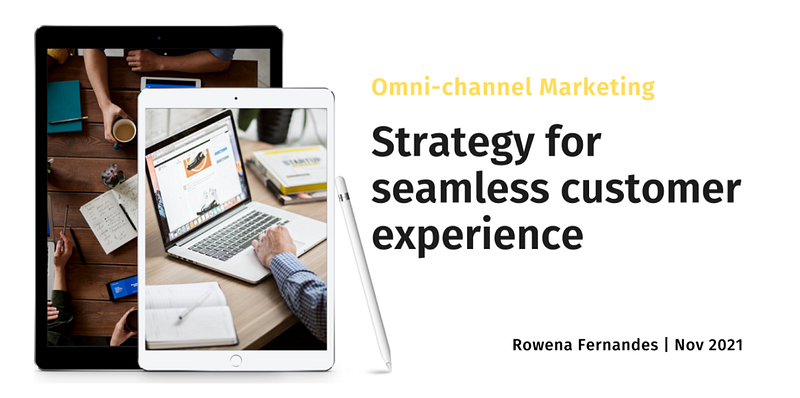

Drive conversions through Customer Experience
By Rowena Fernandes, ‘Challenging Stereotypes.’

Omnichannel is about convenience — providing a seamless experience wherever the customer is!
In the earlier article (March 2021), I mentioned about how customer experiences can help build brand awareness. However while working in the current organization (CaratLane) I realized the importance of having friction-less customer journey across the online and offline channels/devices; and how it not only builds awareness but also drives conversion and even repeat purchases (lower end of the sales funnel).
As marketers, we are all aware that the line between online and offline shopping is getting increasingly blurry. This fact is reflected even in an research by Google wherein 73% of the customers now describe themselves as ‘channel agnostic.’
There are 2 factors which has accelerated this focus on Omni-channel strategy:

Now that we understand the importance of being omni-channel — how should we proceed?
For ease in understanding, mentioned below are few steps to help you launch / re-vamp your omnichannel marketing strategy:
1.Start with the basics: Your website and social media channels
Review your website — is the content on your home page relevant? Are the service/product pages loading on both big and small devices? How easy is it for your site visitor to reach you? Is there a call to action or CTA, on every page?
Likewise you need to relook at all your social media channels and exit the non-relevant channels to ensure that you’re posting consistently and engaging with users who reach out. For example, if you consistently engage with users on Instagram but don’t answer on Facebook, they’ll notice. Focusing on one and neglecting the other will make your brand look inconsistent and unprofessional. For example, Harish Bhat (Brand Custodian for TATA Sons) helps build relevance for the “TATA brand” by regularly posting Short Tata Stories (SHO-T-S) on LinkedIn.
2. Seek to understand your Customer Journey (in detail)
When you add a new channel to your omni-channel strategy, do it for the purpose of better servicing your customers. This trend I noticed for small boutique stores and home bakers who through social media + 3rd party delivery agents (like we-fast, dunzo) + online payment partners (gpay, paytm) were able to better service their customers — wherever they were.
Remember, it’s not just for your company to get more visibility or for you to make more sales — although those are definitely tangible benefits of establishing an omni-channel strategy. But it’s also about making sure your customer has an easy, issue-free experience.
3. Reinforce your “Brand Identity” across all Communication
By being consistent in your messages, visuals, and positioning statements across all channels, platforms, and devices you can ensure that your brand is presented in exactly the same way from platform to platform. In addition, your customers will also be reassured that they can expect a similar brand experience while shopping across channel.
For example, Google is a champion for omni-channel experiences especially its browser — Google Chrome. When users are logged into their Google accounts, their history and activity is automatically synced into every device. Users can even access tabs on their phone app that they left open on their laptop.
4. Strive for personalisation at a mass scale
Thanks to the intelligence and technology available, as marketer we can leverage data to match each piece of content to the right buyer persona to deliver value. Data empowers us to deliver highly relevant and incredibly timely content at scale — in other words, personalisation done well.

For example, Mondelez’s second leg of ‘Not Just a Cadbury ad’ that went on to win two lions this year at Cannes. This ad used machine learning to recreate Shah Rukh Khan’s face and voice to take the local store’s names. The different versions of the same ad with local store names were targeted as per the pin-code of the viewer, showing them only the nearby stores. From garment owners to local sweet shops, all SMBs could visit Cadbury India’s website and create their own version and share it on their social media platforms.
5. End with a appropriate CTA (call-to-action)
Every time you engage with customers on certain channels — whether it’s on an ad, an organic post, a private message, a phone call, or an email — you should end the engagement with a CTA. That CTA should, of course, be device and platform appropriate and should extend the seamless experience you’ve already provided.
For example, when you browse through the webpages of CaratLane website, the visitors who spend more time on product pages and then shown the CTA of connecting with the CaratLane’s customer service to enhance their shopping experience.
To summarise, as marketer we need to focus on delivering a consistent and cohesive omnichannel experience across all touch points to create powerful experiences that will keep customers engaged in delightful and personal ways and keep them returning for more.
Author
Rowena Fernandes
Editor
Mridula Saravanan
We at CaratLane are solving some of the most intriguing challenges to make our mark in the relatively uncharted omnichannel jewellery industry. If you are interested in tackling such obstacles, feel free to drop your updated resume/CV to careers@caratlane.com!

Leave a Reply